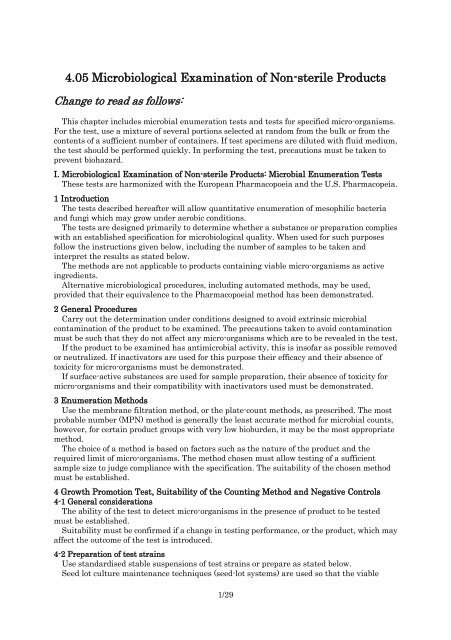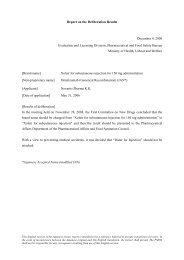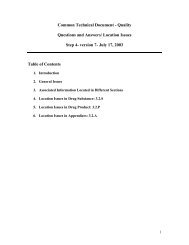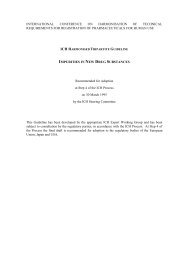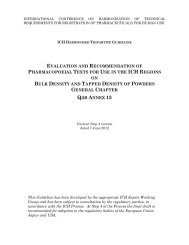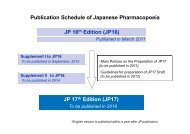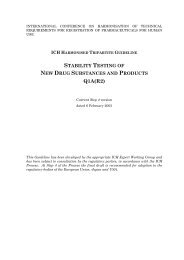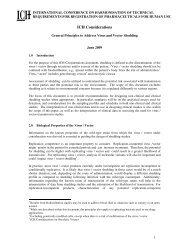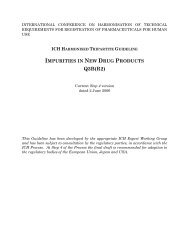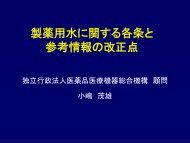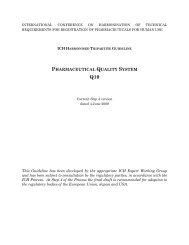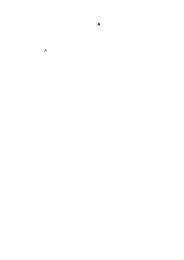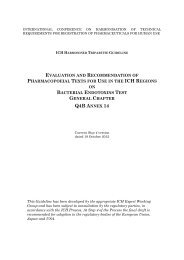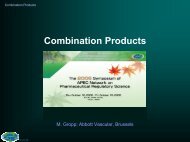4.05 Microbiological Examination of Non-sterile Products
4.05 Microbiological Examination of Non-sterile Products
4.05 Microbiological Examination of Non-sterile Products
- No tags were found...
You also want an ePaper? Increase the reach of your titles
YUMPU automatically turns print PDFs into web optimized ePapers that Google loves.
dehydrated medium or from the ingredients described.Inoculate portions/plates <strong>of</strong> casein soya bean digest broth and casein soya bean digest agarwith a small number (not more than 100 CFU) <strong>of</strong> the micro-organisms indicated in Table<strong>4.05</strong>-I-1, using a separate portion/plate <strong>of</strong> medium for each. Inoculate plates <strong>of</strong>Sabouraud-dextrose agar with a small number (not more than 100 CFU) <strong>of</strong> themicro-organisms indicated in Table <strong>4.05</strong>-I-1, using a separate plate <strong>of</strong> medium for each.Incubate in the conditions described in Table <strong>4.05</strong>-I-1.For solid media, growth obtained must not differ by a factor greater than 2 from thecalculated value for a standardized inoculum. For a freshly prepared inoculum, growth <strong>of</strong> themicro-organisms comparable to that previously obtained with a previously tested andapproved batch <strong>of</strong> medium occurs.Liquid media are suitable if clearly visible growth <strong>of</strong> the micro-organisms comparable tothat previously obtained with a previously tested and approved batch <strong>of</strong> medium occurs.4-5 Suitability <strong>of</strong> the counting method in the presence <strong>of</strong> product4-5-1 Preparation <strong>of</strong> the sampleThe method for sample preparation depends on the physical characteristics <strong>of</strong> the productto be tested. If none <strong>of</strong> the procedures described below can be demonstrated to be satisfactory,an alternative procedure must be developed.Water-soluble products—Dissolve or dilute (usually a 1 in 10 dilution is prepared) the productto be examined in buffered sodium chloride-peptone solution pH 7.0, phosphate buffersolution pH 7.2 or casein soya bean digest broth. If necessary adjust to pH 6 – 8. Furtherdilutions, where necessary, are prepared with the same diluent.<strong>Non</strong>-fatty products insoluble in water—Suspend the product to be examined (usually a 1 in 10dilution is prepared) in buffered sodium chloride-peptone solution pH 7.0, phosphate buffersolution pH 7.2 or casein soya bean digest broth. A surface-active agent such as 1 g/L <strong>of</strong>Polysorbate 80 may be added to assist the suspension <strong>of</strong> poorly wettable substances. Ifnecessary adjust to pH 6 – 8. Further dilutions, where necessary, are prepared with the samediluent.Fatty products—Dissolve in isopropyl myristate, sterilized by filtration or mix the product tobe examined with the minimum necessary quantity <strong>of</strong> <strong>sterile</strong> polysorbate 80 or anothernon-inhibitory <strong>sterile</strong> surface-active reagent, heated if necessary to not more than 40°C, or inexceptional cases to not more than 45°C. Mix carefully and if necessary maintain thetemperature in a water-bath. Add sufficient <strong>of</strong> the pre-warmed chosen diluent to make a 1 in10 dilution <strong>of</strong> the original product. Mix carefully whilst maintaining the temperature for theshortest time necessary for the formation <strong>of</strong> an emulsion. Further serial tenfold dilutions maybe prepared using the chosen diluent containing a suitable concentration <strong>of</strong> <strong>sterile</strong>polysorbate 80 or another non-inhibitory <strong>sterile</strong> surface-active reagent.Fluids or solids in aerosol form—Aseptically transfer the product into a membrane filterapparatus or a <strong>sterile</strong> container for further sampling. Use either the total contents or adefined number <strong>of</strong> metered doses from each <strong>of</strong> the containers tested.Transdermal patches—Remove the protective cover sheets (―release liner‖) <strong>of</strong> the transdermalpatches and place them, adhesive side upwards, on <strong>sterile</strong> glass or plastic trays. Cover theadhesive surface with <strong>sterile</strong> porous material, for example <strong>sterile</strong> gauze, to prevent thepatches from sticking together, and transfer the patches to a suitable volume <strong>of</strong> the chosendiluent containing inactivators such as Polysorbate 80 and/or lecithin. Shake the preparationvigorously for at least 30 min.4-5-2 Inoculation and dilutionAdd to the sample prepared as described above (4-5-1) and to a control (with no testmaterial included) a sufficient volume <strong>of</strong> the microbial suspension to obtain an inoculum <strong>of</strong>not more than 100 CFU. The volume <strong>of</strong> the suspension <strong>of</strong> the inoculum should not exceed 1per cent <strong>of</strong> the volume <strong>of</strong> diluted product.To demonstrate acceptable microbial recovery from the product, the lowest possible dilution3/29
factor <strong>of</strong> the prepared sample must be used for the test. Where this is not possible due toantimicrobial activity or poor solubility, further appropriate protocols must be developed.If inhibition <strong>of</strong> growth by the sample cannot otherwise be avoided, the aliquot <strong>of</strong> themicrobial suspension may be added after neutralization, dilution or filtration.4-5-3 Neutralization/removal <strong>of</strong> antimicrobial activityThe number <strong>of</strong> micro-organisms recovered from the prepared sample diluted as described in4-5-2 and incubated following the procedure described in 4-5-4, is compared to the number <strong>of</strong>micro-organisms recovered from the control preparation.If growth is inhibited (reduction by a factor greater than 2), then modify the procedure forthe particular enumeration test to ensure the validity <strong>of</strong> the results. Modification <strong>of</strong> theprocedure may include, for example, (1) an increase in the volume <strong>of</strong> the diluent or culturemedium, (2) incorporation <strong>of</strong> a specific or general neutralizing agents into the diluent, (3)membrane filtration or (4) a combination <strong>of</strong> the above measures.Neutralizing agents—Neutralizing agents may be used to neutralize the activity <strong>of</strong>antimicrobial agents (Table <strong>4.05</strong>-I-2). They may be added to the chosen diluent or the mediumpreferably before sterilization. If used, their efficacy and their absence <strong>of</strong> toxicity formicro-organisms must be demonstrated by carrying out a blank with neutralizer and withoutproduct.If no suitable neutralizing method can be found, it can be assumed that the failure to isolatethe inoculated organism is attributable to the microbicidal activity <strong>of</strong> the product. Thisinformation serves to indicate that the article is not likely to be contaminated with the givenspecies <strong>of</strong> the micro-organism. However, it is possible that the product only inhibits some <strong>of</strong>the micro-organisms specified herein, but does not inhibit others not included amongst thetest strains or for which the latter are not representative. Then, perform the test with thehighest dilution factor compatible with microbial growth and the specific acceptance criterion.4-5-4 Recovery <strong>of</strong> micro-organism in the presence <strong>of</strong> productFor each <strong>of</strong> the micro-organisms listed in Table <strong>4.05</strong>-I-1, separate tests are performed. Onlymicro-organisms <strong>of</strong> the added test strain are counted.4-5-4-1 Membrane filtrationUse membrane filters having a nominal pore size not greater than 0.45 mm. The type <strong>of</strong>filter material is chosen in such a way that the bacteria-retaining efficiency is not affected bythe components <strong>of</strong> the sample to be investigated. For each <strong>of</strong> the micro-organisms listed inTable <strong>4.05</strong>-I-1, one membrane filter is used.4/29
Transfer a suitable amount <strong>of</strong> the sample prepared as described under 4-5-1 to 4-5-3(preferably representing 1 g <strong>of</strong> the product, or less if large numbers <strong>of</strong> CFU are expected) tothe membrane filter, filter immediately and rinse the membrane filter with an appropriatevolume <strong>of</strong> diluent.For the determination <strong>of</strong> total aerobic microbial count (TAMC), transfer the membranefilter to the surface <strong>of</strong> casein soya bean digest agar. For the determination <strong>of</strong> total combinedyeasts/moulds count (TYMC) transfer the membrane to the surface <strong>of</strong> Sabouraud-dextroseagar. Incubate the plates as indicated in Table <strong>4.05</strong>-I-1. Perform the counting.4-5-4-2 Plate-count methodsPerform plate-count methods at least in duplicate for each medium and use the mean count<strong>of</strong> the result.4-5-4-2-1 Pour-plate methodFor Petri dishes 9 cm in diameter, add to the dish 1 mL <strong>of</strong> the sample prepared as describedunder 4-5-1 to 4-5-3 and 15 – 20 mL <strong>of</strong> casein soya bean digest agar or Sabouraud-dextroseagar, both media being at not more than 45°C. If larger Petri dishes are used, the amount <strong>of</strong>agar medium is increased accordingly. For each <strong>of</strong> the micro-organisms listed in Table<strong>4.05</strong>-I-1, at least 2 Petri dishes are used.Incubate the plates as indicated in Table <strong>4.05</strong>-I-1. Take the arithmetic mean <strong>of</strong> the countsper medium and calculate the number <strong>of</strong> CFU in the original inoculum.4-5-4-2-2 Surface-spread methodFor Petri dishes 9 cm in diameter, add 15 – 20 mL <strong>of</strong> casein soya bean digest agar orSabouraud-dextrose agar at about 45°C to each Petri dish and allow to solidify. If larger Petridishes are used, the volume <strong>of</strong> the agar is increased accordingly. Dry the plates, for examplein a laminar-airflow cabinet or in an incubator. For each <strong>of</strong> the micro-organisms listed inTable <strong>4.05</strong>-I-1, at least 2 Petri dishes are used. Spread a measured volume <strong>of</strong> not less than 0.1mL <strong>of</strong> the sample prepared as described under 4-5-1 to 4-5-3 over the surface <strong>of</strong> the medium.Incubate and count as prescribed under 4-5-4-2-1.4-5-4-3 Most-probable-number (MPN) methodThe precision and accuracy <strong>of</strong> the MPN method is less than that <strong>of</strong> the membrane filtrationmethod or the platecount method. Unreliable results are obtained particularly for theenumeration <strong>of</strong> moulds. For these reasons the MPN method is reserved for the enumeration<strong>of</strong> TAMC in situations where no other method is available. If the use <strong>of</strong> the method is justified,proceed as follows.Prepare a series <strong>of</strong> at least 3 serial tenfold dilutions <strong>of</strong> the product as described under 4-5-1to 4-5-3. From each level <strong>of</strong> dilution, 3 aliquots <strong>of</strong> 1 g or 1 mL are used to inoculate 3 tubeswith 9 – 10 mL <strong>of</strong> casein soya bean digest broth. If necessary a surface-active agent such aspolysorbate 80, or an inactivator <strong>of</strong> antimicrobial agents may be added to the medium. Thus,if 3 levels <strong>of</strong> dilution are prepared 9 tubes are inoculated.Incubate all tubes at 30 – 35°C for not more than 3 days. If reading <strong>of</strong> the results is difficultor uncertain owing to the nature <strong>of</strong> the product to be examined, subculture in the same broth,or casein soya bean digest agar, for 1 – 2 days at the same temperature and use these results.Determine the most probable number <strong>of</strong> micro-organisms per gram or milliliter <strong>of</strong> the productto be examined from Table <strong>4.05</strong>-I-3.4-6 Results and interpretationWhen verifying the suitability <strong>of</strong> the membrane filtration method or the plate-count method,a mean count <strong>of</strong> any <strong>of</strong> the test organisms not differing by a factor greater than 2 from thevalue <strong>of</strong> the control defined in 4-5-2 in the absence <strong>of</strong> the product must be obtained. Whenverifying the suitability <strong>of</strong> the MPN method the calculated value from the inoculum must bewithin 95 per cent confidence limits <strong>of</strong> the results obtained with the control.If the above criteria cannot be met for one or more <strong>of</strong> the organisms tested with any <strong>of</strong> thedescribed methods, the method and test conditions that come closest to the criteria are used5/29
to test the product.5 Testing <strong>of</strong> <strong>Products</strong>5-1 Amount used for the testUnless otherwise prescribed, use 10 g or 10 mL <strong>of</strong> the product to be examined taken withthe precautions referred to above. For fluids or solids in aerosol form, sample 10 containers.For transdermal patches, sample 10 patches.The amount to be tested may be reduced for active substances that will be formulated in thefollowing conditions: the amount per dosage unit (e.g. tablet, capsule, injection) is less than orequal to 1 mg or the amount per gram or milliliter (for preparations not presented in doseunits) is less than 1 mg. In these cases, the amount <strong>of</strong> sample to be tested is not less than theamount present in 10 dosage units or 10 g or 10 mL <strong>of</strong> the product.For materials used as active substances where sample quantity is limited or batch size isextremely small (i.e. less than 1000 mL or 1000 g), the amount tested shall be 1 per cent <strong>of</strong> thebatch unless a lesser amount is prescribed or justified and authorised.For products where the total number <strong>of</strong> entities in a batch is less than 200 (e.g. samplesused in clinical trials), the sample size may be reduced to 2 units, or 1 unit if the size is lessthan 100.Select the sample(s) at random from the bulk material or from the available containers <strong>of</strong>the preparation. To obtain the required quantity, mix the contents <strong>of</strong> a sufficient number <strong>of</strong>containers to provide the sample.5-2 <strong>Examination</strong> <strong>of</strong> the product5-2-1 Membrane filtrationUse a filtration apparatus designed to allow the transfer <strong>of</strong> the filter to the medium.Prepare the sample using a method that has been shown suitable as described in section 4and transfer the appropriate amount to each <strong>of</strong> 2 membrane filters and filter immediately.Wash each filter following the procedure shown to be suitable.For the determination <strong>of</strong> TAMC, transfer one <strong>of</strong> the membrane filters to the surface <strong>of</strong>casein soya bean digest agar. For the determination <strong>of</strong> TYMC, transfer the other membraneto the surface <strong>of</strong> Sabouraud-dextrose agar. Incubate the plate <strong>of</strong> casein soya bean digest agarat 30 – 35°C for 3 – 5 days and the plate <strong>of</strong> Sabouraud-dextrose agar at 20 – 25°C for 5 – 7days. Calculate the number <strong>of</strong> CFU per gram or per millilitre <strong>of</strong> product.When examining transdermal patches, filter 10 per cent <strong>of</strong> the volume <strong>of</strong> the preparationdescribed under 4-5-1 separately through each <strong>of</strong> 2 <strong>sterile</strong> filter membranes. Transfer onemembrane to casein soya bean digest agar for TAMC and the other membrane toSabouraud-dextrose agar for TYMC.5-2-2 Plate-count methods5-2-2-1 Pour-plate methodPrepare the sample using a method that has been shown to be suitable as described insection 4. Prepare for each medium at least 2 Petri dishes for each level <strong>of</strong> dilution. Incubatethe plates <strong>of</strong> casein soya bean digest agar at 30 – 35°C for 3 – 5 days and the plates <strong>of</strong>Sabouraud-dextrose agar at 20 – 25°C for 5 – 7 days. Select the plates corresponding to agiven dilution and showing the highest number <strong>of</strong> colonies less than 250 for TAMC and 50 forTYMC. Take the arithmetic mean per culture medium <strong>of</strong> the counts and calculate the number<strong>of</strong> CFU per gram or per millilitre <strong>of</strong> product.5-2-2-2 Surface-spread methodPrepare the sample using a method that has been shown to be suitable as described insection 4. Prepare at least 2 Petri dishes for each medium and each level <strong>of</strong> dilution. Forincubation and calculation <strong>of</strong> the number <strong>of</strong> CFU proceed as described for the pour-platemethod.5-2-3 Most-probable-number methodPrepare and dilute the sample using a method that has been shown to be suitable as6/29
described in section 4. Incubate all tubes for 3 – 5 days at 30 – 35°C. Subculture if necessary,using the procedure shown to be suitable. Record for each level <strong>of</strong> dilution the number <strong>of</strong>tubes showing microbial growth. Determine the most probable number <strong>of</strong> micro-organismsper gram or millilitre <strong>of</strong> the product to be examined from Table <strong>4.05</strong>-I-3.5-3 Interpretation <strong>of</strong> the resultsThe total aerobic microbial count (TAMC) is considered to be equal to the number <strong>of</strong> CFUfound using casein soya bean digest agar; if colonies <strong>of</strong> fungi are detected on this medium,they are counted as part <strong>of</strong> TAMC. The total combined yeasts/mould count (TYMC) isconsidered to be equal to the number <strong>of</strong> CFU found using Sabouraud-dextrose agar; if colonies<strong>of</strong> bacteria are detected on this medium, they are counted as part <strong>of</strong> TYMC. When the TYMCis expected to exceed the acceptance criterion due to the bacterial growth,Sabouraud-dextrose agar containing antibiotics may be used. If the count is carried out by theMPN method the calculated value is the TAMC.When an acceptance criterion for microbiological quality is prescribed it is interpreted asfollows:-10 1 CFU: maximum acceptable count=20,-10 2 CFU: maximum acceptable count=200,-10 3 CFU: maximum acceptable count=2000, and so forth.The recommended solutions and media are described in Tests for specifiedmicro-organisms.7/29
II. <strong>Microbiological</strong> <strong>Examination</strong> <strong>of</strong> <strong>Non</strong>-<strong>sterile</strong> <strong>Products</strong>: Tests for SpecifiedMicro-organismsThese tests are harmonized with the European Pharmacopoeia and the U.S. Pharmacopeia.1 IntroductionThe tests described hereafter will allow determination <strong>of</strong> the absence <strong>of</strong>, or limitedoccurrence <strong>of</strong> specified microorganisms which may be detected under the conditionsdescribed.The tests are designed primarily to determine whether a substance or preparation complies8/29
with an established specification for microbiological quality. When used for such purposesfollow the instructions given below, including the number <strong>of</strong> samples to be taken andinterpret the results as stated below.Alternative microbiological procedures, including automated methods may be used,provided that their equivalence to the Pharmacopoeial method has been demonstrated.2 General ProceduresThe preparation <strong>of</strong> samples is carried out as described in Microbial enumeration tests.If the product to be examined has antimicrobial activity, this is ins<strong>of</strong>ar as possible removedor neutralized as described in Microbial enumeration tests.If surface-active substances are used for sample preparation, their absence <strong>of</strong> toxicity formicro-organisms and their compatibility with inactivators used must be demonstrated asdescribed in Microbial enumeration tests.3 Growth Promoting and Inhibitory Properties <strong>of</strong> the Media, Suitability <strong>of</strong> the Test andNegative ControlsThe ability <strong>of</strong> the test to detect micro-organisms in the presence <strong>of</strong> the product to be testedmust be established. Suitability must be confirmed if a change in testing performance, or theproduct, which may affect the outcome <strong>of</strong> the test is introduced.3-1 Preparation <strong>of</strong> test strainsUse standardised stable suspensions <strong>of</strong> test strains or prepare as stated below. Seed lotculture maintenance techniques (seed-lot systems) are used so that the viablemicroorganisms used for inoculation are not more than 5 passages removed from the originalmaster seed-lot.3-1-1 Aerobic micro-organismsGrow each <strong>of</strong> the bacterial test strains separately in containers containing casein soya beandigest broth or on casein soya bean digest agar at 30 – 35°C for 18 – 24 hours. Grow the teststrain for Candida albicans separately on Sabouraud-dextrose agar or in Sabouraud-dextrosebroth at 20 – 25°C for 2–3 days.Staphylococcus aureus such as ATCC 6538, NCIMB 9518, CIP 4.83 or NBRC 13276,Pseudomonas aeruginosa such as ATCC 9027, NCIMB 8626, CIP 82.118 or NBRC 13275,Escherichia coli such as ATCC 8739, NCIMB 8545, CIP 53.126 or NBRC 3972,Salmonella enterica subsp. enterica serovar Typhimurium such as ATCC 14028 or, as analternative,Salmonella enterica subsp. enterica serovar Abony such as NBRC 100797, NCTC 6017 orCIP 80.39,Candida albicans such as ATCC 10231, NCPF 3179, IP 48.72 or NBRC 1594.Use buffered sodium chloride-peptone solution pH 7.0 or phosphate buffer solution pH 7.2to make test suspensions. Use the suspensions within 2 hours or within 24 hours if stored at 2– 8°C.3-1-2 ClostridiaUse Clostridium sporogenes such as ATCC 11437 (NBRC 14293, NCIMB 12343, CIP100651) or ATCC 19404 (NCTC 532 or CIP 79.3). Grow the clostridial test strain underanaerobic conditions in reinforced medium for Clostridia at 30 – 35°C for 24 – 48 hours. As analternative to preparing and then diluting down a fresh suspension <strong>of</strong> vegetative cells <strong>of</strong> Cl.sporogenes, a stable spore suspension is used for test inoculation. The stable spore suspensionmay be maintained at 2 – 8°C for a validated period.3-2 Negative controlTo verify testing conditions a negative control is performed using the chosen diluent inplace <strong>of</strong> the test preparation. There must be no growth <strong>of</strong> micro-organisms. A negative controlis also performed when testing the products as described under 4. A failed negative controlrequires an investigation.9/29
3-3 Growth promotion and inhibitory properties <strong>of</strong> the mediaTest each batch <strong>of</strong> ready-prepared medium and each batch <strong>of</strong> medium prepared either fromdehydrated medium or from ingredients.Verify suitable properties <strong>of</strong> relevant media as described in Table <strong>4.05</strong>-II-1.Test for growth promoting properties, liquid media: inoculate a portion <strong>of</strong> the appropriatemedium with a small number (not more than 100 CFU) <strong>of</strong> the appropriate microorganism.Incubate at the specified temperature for not more than the shortest period <strong>of</strong> time specifiedin the test. Clearly visible growth <strong>of</strong> the micro-organism comparable to that previouslyobtained with a previously tested and approved batch <strong>of</strong> medium occurs.Test for growth promoting properties, solid media: perform surface-spread method,inoculating each plate with a small number (not more than 100 CFU) <strong>of</strong> the appropriatemicro-organism. Incubate at the specified temperature for not more than the shortest period<strong>of</strong> time specified in the test. Growth <strong>of</strong> the micro-organism comparable to that previouslyobtained with a previously tested and approved batch <strong>of</strong> medium occurs.Test for inhibitory properties, liquid or solid media: inoculate the appropriate medium withat least 100 CFU <strong>of</strong> the appropriate micro-organism. Incubate at the specified temperaturefor not less than the longest period <strong>of</strong> time specified in the test. No growth <strong>of</strong> the testmicro-organism occurs.Test for indicative properties: perform surface-spread method, inoculating each plate with asmall number (not more than 100 CFU) <strong>of</strong> the appropriate micro-organism. Incubate at thespecified temperature for a period <strong>of</strong> time within the range specified in the test. Colonies arecomparable in appearance and indication reactions to those previously obtained with apreviously tested and approved batch <strong>of</strong> medium.3-4 Suitability <strong>of</strong> the test methodFor each product to be tested perform sample preparation as described in the relevantparagraph in section 4. Add each test strain at the time <strong>of</strong> mixing, in the prescribed growthmedium. Inoculate the test strains individually. Use a number <strong>of</strong> micro-organisms equivalentto not more than 100 CFU in the inoculated test preparation.Perform the test as described in the relevant paragraph in section 4 using the shortestincubation period prescribed.The specified micro-organisms must be detected with the indication reactions as describedin section 4.Any antimicrobial activity <strong>of</strong> the product necessitates a modification <strong>of</strong> the test procedure(see 4-5-3 <strong>of</strong> Microbial Enumeration Tests).If for a given product the antimicrobial activity with respect to a micro-organism for whichtesting is prescribed cannot be neutralised, then it is to be assumed that the inhibitedmicro-organism will not be present in the product.4 Testing <strong>of</strong> <strong>Products</strong>4-1 Bile-tolerant gram-negative bacteria4-1-1 Sample preparation and pre-incubationPrepare a sample using a 1 in 10 dilution <strong>of</strong> not less than 1 g <strong>of</strong> the product to be examinedas described in Microbial enumeration tests, but using casein soya bean digest broth as thechosen diluent, mix and incubate at 20 – 25°C for a time sufficient to resuscitate the bacteriabut not sufficient to encourage multiplication <strong>of</strong> the organisms (usually 2 hours but not morethan 5 hours).4-1-2 Test for absenceUnless otherwise prescribed use the volume corresponding to 1 g <strong>of</strong> the product, asprepared in 4-1-1 to inoculate enterobacteria enrichment broth-Mossel. Incubate at 30 – 35°Cfor 24 – 48 hours. Subculture on plates <strong>of</strong> violet red bile glucose agar. Incubate at 30 – 35°Cfor 18 – 24 hours.The product complies with the test if there is no growth <strong>of</strong> colonies.10/29
4-1-3 Quantitative test4-1-3-1 Selection and subcultureInoculate suitable quantities <strong>of</strong> enterobacteria enrichment broth-Mossel with thepreparation as described under 4-1-1 and/or dilutions <strong>of</strong> it containing respectively 0.1 g, 0.01 gand 0.001 g (or 0.1 mL, 0.01 mL and 0.001 mL) <strong>of</strong> the product to be examined. Incubate at 30– 35°C for 24 – 48 hours. Subculture each <strong>of</strong> the cultures on a plate <strong>of</strong> violet red bile glucoseagar. Incubate at 30–35°C for 18 – 24 hours.4-1-3-2 InterpretationGrowth <strong>of</strong> colonies constitutes a positive result. Note the smallest quantity <strong>of</strong> the productthat gives a positive result and the largest quantity that gives a negative result. Determinefrom Table <strong>4.05</strong>-II-2 the probable number <strong>of</strong> bacteria.4-2 Escherichia coli4-2-1 Sample preparation and pre-incubationPrepare a sample using a 1 in 10 dilution <strong>of</strong> not less than 1 g <strong>of</strong> the product to be examinedas described in Microbial enumeration tests and use 10 mL or the quantity corresponding to 1g or 1 mL to inoculate a suitable amount (determined as described under 3-4) <strong>of</strong> casein soyabean digest broth, mix and incubate at 30 – 35°C for 18 – 24 hours.4-2-2 Selection and subcultureShake the container, transfer 1 mL <strong>of</strong> casein soya bean digest broth to 100 mL <strong>of</strong>MacConkey broth and incubate at 42 – 44°C for 24 – 48 hours. Subculture on a plate <strong>of</strong> Mac-Conkey agar at 30 – 35°C for 18 – 72 hours.4-2-3 InterpretationGrowth <strong>of</strong> colonies indicates the possible presence <strong>of</strong> E. coli. This is confirmed byidentification tests.The product complies with the test if no colonies are present or if the identification tests arenegative.4-3 Salmonella4-3-1 Sample preparation and pre-incubationPrepare the product to be examined as described in Microbial enumeration tests and usethe quantity corresponding to not less than 10 g or 10 mL to inoculate a suitable amount(determined as described under 3-4) <strong>of</strong> casein soya bean digest broth, mix and incubate at 30– 359C for 18 – 24 hours.4-3-2 Selection and subcultureTransfer 0.1 mL <strong>of</strong> casein soya bean digest broth to 10 mL <strong>of</strong> Rappaport VassiliadisSalmonella enrichment broth and incubate at 30 – 35°C for 18 – 24 hours. Subculture onplates <strong>of</strong> xylose, lysine, deoxycholate agar. Incubate at 30 – 35°C for 18 – 48 hours.4-3-3 InterpretationThe possible presence <strong>of</strong> Salmonella is indicated by the growth <strong>of</strong> well-developed, redcolonies, with or without black centres. This is confirmed by identification tests.The product complies with the test if colonies <strong>of</strong> the types described are not present or if theconfirmatory identification tests are negative.4-4 Pseudomonas aeruginosa4-4-1 Sample preparation and pre-incubationPrepare a sample using a 1 in 10 dilution <strong>of</strong> not less than 1 g <strong>of</strong> the product to be examinedas described in Microbial enumeration tests and use 10 mL or the quantity corresponding to 1g or 1 mL to inoculate a suitable amount (determined as described under 3-4) <strong>of</strong> casein soyabean digest broth and mix. When testing transdermal patches, filter the volume <strong>of</strong> samplecorresponding to 1 patch <strong>of</strong> the preparation described in Microbial enumeration tests (4-5-1)through a <strong>sterile</strong> filter membrane and place in 100 mL <strong>of</strong> casein soya bean digest broth.11/29
Incubate at 30 – 35°C for 18 – 24 hours.4-4-2 Selection and subcultureSubculture on a plate <strong>of</strong> cetrimide agar and incubate at 30 – 35°C for 18 – 72 hours.4-4-3 InterpretationGrowth <strong>of</strong> colonies indicates the possible presence <strong>of</strong> P. aeruginosa. This is confirmed byidentification tests.The product complies with the test if colonies are not present or if the confirmatoryidentification tests are negative.4-5 Staphylococcus aureus4-5-1 Sample preparation and pre-incubationPrepare a sample using a 1 in 10 dilution <strong>of</strong> not less than 1 g <strong>of</strong> the product to be examinedas described in Microbial enumeration tests and use 10 mL or the quantity corresponding to 1g or 1 mL to inoculate a suitable amount (determined as described under 3-4) <strong>of</strong> casein soyabean digest broth and homogenise. When testing transdermal patches, filter the volume <strong>of</strong>sample corresponding to 1 patch <strong>of</strong> the preparation described in Microbial enumeration tests(4-5-1) through a <strong>sterile</strong> filter membrane and place in 100 mL <strong>of</strong> casein soya bean digest broth.Incubate at 30 – 35°C for 18 – 24 hours.4-5-2 Selection and subcultureSubculture on a plate <strong>of</strong> mannitol salt agar and incubate at 30 – 35°C for 18 – 72 hours.4-5-3 InterpretationThe possible presence <strong>of</strong> S. aureus is indicated by the growth <strong>of</strong> yellow/white coloniessurrounded by a yellow zone. This is confirmed by identification tests.The product complies with the test if colonies <strong>of</strong> the types described are not present or if theconfirmatory identification tests are negative.4-6 Clostridia4-6-1 Sample preparation and heat treatmentPrepare a sample using a 1 in 10 dilution (with a minimum total volume <strong>of</strong> 20 mL) <strong>of</strong> notless than 2 g or 2 mL <strong>of</strong> the product to be examined as described in Microbial enumerationtests.Divide the sample into two portions <strong>of</strong> at least 10 mL. Heat 1 portion at 80°C for 10 min andcool rapidly. Do not heat the other portion.4-6-2 Selection and subcultureUse 10 mL or the quantity corresponding to 1 g or 1 mL <strong>of</strong> the product to be examined <strong>of</strong>both portions to inoculate suitable amounts (determined as described under 3-4) <strong>of</strong> Reinforcedclostridium medium. Incubate under anaerobic conditions at 30 – 35°C for 48 hours. Afterincubation, make subcultures from each container on Columbia agar and incubate underanaerobic conditions at 30 – 35°C for 48 – 72 hours.4-6-3 InterpretationThe occurrence <strong>of</strong> anaerobic growth <strong>of</strong> rods (with or without endospores) giving a negativecatalase reaction indicates the presence <strong>of</strong> Clostridia. This is confirmed by identification tests.The product compiles with the test if colonies <strong>of</strong> the types described are not present or if theconfirmatory identification tests are negative.4-7 Candida albicans4-7-1 Sample preparation and pre-incubationPrepare the product to be examined as described in Microbial enumeration tests and use 10mL or the quantity corresponding to not less than 1 g or 1 mL to inoculate 100 mL <strong>of</strong>Sabouraud-dextrose broth and mix. Incubate at 30 – 35°C for 3-5 days.4-7-2 Selection and subcultureSubculture on a plate <strong>of</strong> Sabouraud-dextrose agar and incubate at 30 – 35°C for 24 – 4812/29
hours.4-7-3 InterpretationGrowth <strong>of</strong> white colonies may indicate the presence <strong>of</strong> C. albicans. This is confirmed byidentification tests.The product complies with the test if such colonies are not present or if the confirmatoryidentification tests are negative.The following section is given for information.5 Recommended Solutions and Culture MediaThe following solutions and culture media have been found satisfactory for the purposes forwhich they are prescribed in the test for microbial contamination in the Pharmacopoeia.Other media may be used provided that their suitability can be demonstrated.Stock buffer solution. Transfer 34 g <strong>of</strong> potassium dihydrogen phosphate to a 1000 mLvolumetric flask, dissolve in 500 mL <strong>of</strong> purified water, adjust to pH 7.2±0.2 with sodiumhydroxide, add purified water to volume and mix. Dispense in containers and sterilize. Storeat a temperature <strong>of</strong> 2 – 8°C.Phosphate buffer solution pH 7.2Prepare a mixture <strong>of</strong> purified water and stock buffer solution (800:1 V/V) and sterilize.Buffered sodium chloride-peptone solution pH 7.0Potassium dihydrogen phosphateDisodium hydrogen phosphate dehydrateSodium chloridePeptone (meat or casein)Purified waterSterilize in an autoclave using a validated cycle.3.6 g7.2 g equivalent to 0.067 mol phosphate4.3 g1.0 g1000 mLCasein soya bean digest brothPancreatic digest <strong>of</strong> casein17.0 gPapaic digest <strong>of</strong> soya bean3.0 gSodium chloride5.0 gDipotassium hydrogen phosphate2.5 gGlucose monohydrate2.5 gPurified water1000 mLAdjust the pH so that after sterilization it is 7.3±0.2 at 25°C. Sterilize in an autoclave usinga validated cycle.Casein soya bean digest agarPancreatic digest <strong>of</strong> casein15.0 gPapaic digest <strong>of</strong> soya bean5.0 gSodium chloride5.0 gAgar15.0 gPurified water1000 mLAdjust the pH so that after sterilization it is 7.3±0.2 at 25°C. Sterilize in an autoclave usinga validated cycle.Sabouraud-dextrose agarGlucose40.0 gMixture <strong>of</strong> peptic digest <strong>of</strong> animal tissue and pancreatic digest <strong>of</strong> casein (1:1) 10.0 gAgar15.0 gPurified water1000 mLAdjust the pH so that after sterilization it is 5.6±0.2 at 25°C. Sterilize in an autoclave usinga validated cycle.13/29
Potato dextrose agarInfusion from potatoes200 gGlucose20.0 gAgar15.0 gPurified water1000 mLAdjust the pH so that after sterilization it is 5.6±0.2 at 25°C. Sterilize in an autoclave usinga validated cycle.Sabouraud-dextrose brothGlucose20.0 gMixture <strong>of</strong> peptic digest <strong>of</strong> animal tissue and pancreatic digest <strong>of</strong> casein (1:1) 10.0 gPurified water1000 mLAdjust the pH so that after sterilization it is 5.6±0.2 at 25°C. Sterilize in an autoclave usinga validated cycle.Enterobacteria enrichment broth-MosselPancreatic digest <strong>of</strong> gelatin10.0 gGlucose monohydrate5.0 gDehydrated ox bile20.0 gPotassium dihydrogen phosphate2.0 gDisodium hydrogen phosphate dehydrate8.0 gBrilliant green15 mgPurified water1000 mLAdjust the pH so that after heating it is 7.2±0.2 at 25°C. Heat at 1009C for 30 min and coolimmediately.Violet red bile glucose agarYeast extract3.0 gPancreatic digest <strong>of</strong> gelatin7.0 gBile salts1.5 gSodium chloride5.0 gGlucose monohydrate10.0 gAgar15.0 gNeutral red30 mgCrystal violet2 mgPurified water1000 mLAdjust the pH so that after heating it is 7.4±0.2 at 25°C. Heat to boiling; do not heat in anautoclave.MacConkey brothPancreatic digest <strong>of</strong> gelatin20.0 gLactose monohydrate10.0 gDehydrated ox bile5.0 gBromocresol purple10 mgPurified water1000 mLAdjust the pH so that after sterilization it is 7.3±0.2 at 25°C. Sterilize in an autoclave usinga validated cycle.MacConkey agarPancreatic digest <strong>of</strong> gelatinPeptones (meat and casein)Lactose monohydrateSodium chlorideBile saltsAgarNeutral red14/2917.0 g3.0 g10.0 g5.0 g1.5 g13.5 g30 mg
Crystal violet1 mgPurified water1000 mLAdjust the pH so that after sterilization it is 7.1±0.2 at 25°C. Boil for 1 min with constantshaking then sterilize in an autoclave using a validated cycle.Rappaport Vassiliadis Salmonella enrichment brothSoya peptone4.5 gMagnesium chloride hexahydrate29.0 gSodium chloride8.0 gDipotassium hydrogen phosphate0.4 gPotassium dihydrogen phosphate0.6 gMalachite green36 mgPurified water1000 mLDissolve, warming slightly. Sterilize in an autoclave using a validated cycle, at atemperature not exceeding 115°C. The pH is to be 5.2±0.2 at 25°C after heating andautoclaving.Xylose, lysine, deoxycholate agarXylose3.5 gL-Lysine5.0 gLactose monohydrate7.5 gSucrose7.5 gSodium chloride5.0 gYeast extract3.0 gPhenol red80 mgAgar13.5 gSodium deoxycholate2.5 gSodium thiosulfate6.8 gAmmonium iron (III) citrate0.8 gPurified water1000 mLAdjust the pH so that after heating it is 7.4±0.2 at 25°C. Heat to boiling, cool to 50°C andpour into Petri dishes. Do not heat in an autoclave.Cetrimide agarPancreatic digest <strong>of</strong> gelatin20.0 gMagnesium chloride1.4 gDipotassium sulfate10.0 gCetrimide0.3 gAgar13.6 gPurified water1000 mLGlycerol10.0 mLHeat to boiling for 1 min with shaking. Adjust the pH so that after sterilization it is 7.2±0.2at 25°C. Sterilize in an autoclave using a validated cycle.Mannitol salt agarPancreatic digest <strong>of</strong> casein5.0 gPeptic digest <strong>of</strong> animal tissue5.0 gBeef extract1.0 gD-Mannitol10.0 gSodium chloride75.0 gAgar15.0 gPhenol red25 mgPurified water1000 mLHeat to boiling for 1 min with shaking. Adjust the pH so that after sterilization it is 7.4±0.2at 25°C. Sterilize in an autoclave using a validated cycle.15/29
Reinforced medium for ClostridiaBeef extract10.0 gPeptone10.0 gYeast extract3.0 gSoluble starch1.0 gGlucose monohydrate5.0 gCysteine hydrochloride0.5 gSodium chloride5.0 gSodium acetate3.0 gAgar0.5 gPurified water1000 mLHydrate the agar, dissolve by heating to boiling with continuous stirring. If necessary,adjust the pH so that after sterilization it is about 6.8±0.2 at 25°C. Sterilize in an autoclaveusing a validated cycle.Columbia agarPancreatic digest <strong>of</strong> casein10.0 gMeat peptic digest5.0 gHeart pancreatic digest3.0 gYeast extract5.0 gCorn starch1.0 gSodium chloride5.0 gAgar, according to gelling power10.0 g to 15.0 gPurified water1000 mLHydrate the agar, dissolve by heating to boiling with continuous stirring. If necessary,adjust the pH so that after sterilization it is 7.3±0.2 at 25°C. Sterilize in an autoclave using avalidated cycle. Allow to cool to 45 – 50°C; add, where necessary, gentamicin sulfatecorresponding to 20 mg <strong>of</strong> gentamicin base and pour into Petri dishes.16/29
17/29
18/29
Change to read as follows:4.06 Sterility TestThis test is harmonized with the European Pharmacopoeia and the U. S. Pharmacopeia.The test is applied to substances, preparations or articles which, according to thePharmacopoeia, are required to be <strong>sterile</strong>. However, a satisfactory result only indicates thatno contaminating micro-organism has been found in the sample examined in the conditions <strong>of</strong>the test.1. Precautions against microbial contaminationThe test for sterility is carried out under aseptic conditions. In order to achieve suchconditions, the test environment has to be adapted to the way in which the sterility test isperformed. The precautions taken to avoid contamination are such that they do not affect anymicro-organisms which are to be revealed in the test. The working conditions in which thetests are performed are monitored regularly by appropriate sampling <strong>of</strong> the working area andby carrying out appropriate controls.2. Culture media and incubation temperatures2.1. IntroductionMedia for the test may be prepared as described below, or equivalent commercial media maybe used provided that they comply with the growth promotion test.The following culture media have been found to be suitable for the test for sterility. Fluidthioglycollate medium is primarily intended for the culture <strong>of</strong> anaerobic bacteria; however, itwill also detect aerobic bacteria. Soya-bean casein digest medium is suitable for the culture <strong>of</strong>both fungi and aerobic bacteria.2.2. Fluid thioglycollate mediumFluid thioglycollate mediumL-CystineAgarSodium chlorideGlucose monohydrate/anhydrousYeast extract (water-soluble)Pancreatic digest <strong>of</strong> caseinSodium thioglycollate orThioglycollic acidResazurin sodium solution (1 in 1000), freshly preparedWater(pH after sterilization 7.1 ± 0.2)0.5 g0.75 g2.5 g5.5 / 5.0 g5.0 g15.0 g0.5 g0.3 mL1.0 mL1 000 mL19/29
Mix the L-cystine, agar, sodium chloride, glucose, water-soluble yeast extract and pancreaticdigest <strong>of</strong> casein with water, and heat until solution is effected. Dissolve the sodiumthioglycollate or thioglycollic acid in the solution and, if necessary, add sodium hydroxide TSso that, after sterilization, the solution will have a pH <strong>of</strong> 7.1 ± 0.2. If filtration is necessary,heat the solution again without boiling and filter while hot through moistened filter paper.Add the resazurin sodium solution (1 in 1000), mix and place the medium in suitable vesselswhich provide a ratio <strong>of</strong> surface to depth <strong>of</strong> medium such that not more than the upper half <strong>of</strong>the medium has undergone a colour change indicative <strong>of</strong> oxygen uptake at the end <strong>of</strong> theincubation period. Sterilize using a validated process. If the medium is stored, store at atemperature between 2 °C and 25 °C in a <strong>sterile</strong>, tight container. If more than the upperone-third <strong>of</strong> the medium has acquired a pink colour, the medium may be restored once byheating the containers in a water-bath or in free-flowing steam until the pink colourdisappears and cooling quickly, taking care to prevent the introduction <strong>of</strong> non-<strong>sterile</strong> air intothe container. Do not use the medium for a longer storage period than has been validated.Fluid thioglycollate medium is to be incubated at 30-35 °C.For products containing a mercurial preservative that cannot be tested by themembrane-filtration method, fluid thioglycollate medium incubated at 20-25 °C may be usedinstead <strong>of</strong> soya-bean casein digest medium provided that it has been validated as described ingrowth promotion test.Where prescribed or justified and authorized, the following alternative thioglycollatemedium might be used. Prepare a mixture having the same composition as that <strong>of</strong> the fluidthioglycollate medium, but omitting the agar and the resazurin sodium solution (1 in 1000),sterilize as directed above. The pH after sterilization is 7.1 ± 0.2. Heat in a water bath prior touse and incubate at 30-35 °C under anaerobic conditions.2.3. Soya-bean casein digest mediumSoya-bean casein digest mediumPancreatic digest <strong>of</strong> caseinPapaic digest <strong>of</strong> soya-bean mealSodium chlorideDipotassium hydrogen phosphateGlucose monohydrate/anhydrousWater(pH after sterilization 7.3 ± 0.2)17.0 g3.0 g5.0 g2.5 g2.5 / 2.3 g1000 mLDissolve the solids in water, warming slightly to effect solution. Cool the solution to roomtemperature. Add sodium hydroxide TS, if necessary, so that after sterilization the solutionwill have a pH <strong>of</strong> 7.3 ± 0.2. Filter, if necessary, to clarify, distribute into suitable vessels andsterilize using a validated process. Store at a temperature between 2 °C and 25 °C in a <strong>sterile</strong>tight container, unless it is intended for immediate use. Do not use the medium for a longerstorage period than has been validated.Soya-bean casein digest medium is to be incubated at 20-25 °C.3. Suitability <strong>of</strong> the culture mediumThe media used comply with the following tests, carried out before or in parallel with thetest on the product to be examined.Sterility20/29
Incubate portions <strong>of</strong> the media for 14 days. No growth <strong>of</strong> micro-organisms occurs.Growth promotion test <strong>of</strong> aerobes, anaerobes and fungiTest each batch <strong>of</strong> ready-prepared medium and each batch <strong>of</strong> medium prepared either fromdehydrated medium or from ingredients. Suitable strains <strong>of</strong> micro-organisms are indicated inTable 4.06 -1.Inoculate portions <strong>of</strong> fluid thioglycollate medium with a small number (not more than 100CFU) <strong>of</strong> the following micro-organisms, using a separate portion <strong>of</strong> medium for each <strong>of</strong> thefollowing species <strong>of</strong> micro-organism: Clostridium sporogenes, Pseudomonas aeruginosa,Staphylococcus aureus.Inoculate portions <strong>of</strong> soya-bean casein digest medium with a small number (not more than100 CFU) <strong>of</strong> the following micro-organisms, using a separate portion <strong>of</strong> medium for each <strong>of</strong> thefollowing species <strong>of</strong> micro-organism: Aspergillus niger, Bacillus subtilis, Candida albicans.Incubate for not more than 3 days in the case <strong>of</strong> bacteria and not more than 5 days in thecase <strong>of</strong> fungi.Seed lot culture maintenance techniques (seed-lot systems) are used so that the viablemicro-organisms used for inoculation are not more than five passages removed from theoriginal master seed-lot.The media are suitable if a clearly visible growth <strong>of</strong> the micro-organisms occursAerobic bacteriaTable 4.06 -1 — Strains <strong>of</strong> the test micro-organisms suitable for use in theGrowth Promotion Test and the Method suitability TestStaphylococcus aureus ATCC 6538, NBRC 13276, CIP 4.83, NCTC 10788,NCIMB 9518Bacillus subtilis ATCC 6633, NBRC 3134, CIP 52.62, NCIMB 8054Pseudomonas aeruginosa ATCC 9027, NBRC 13275, NCIMB 8626, CIP 82.118Anaerobic bacteriumClostridium sporogenes ATCC 19404, NBRC 14293, CIP 79.3, NCTC 532 ,FungiATCC 11437Candida albicans ATCC 10231, NBRC 1594, IP 48.72, NCPF 3179Aspergillus niger ATCC 16404, NBRC 9455, IP 1431.83, IMI 1490074. Method suitability testCarry out a test as described below under Test for sterility <strong>of</strong> the product to be examinedusing exactly the same methods except for the following modifications.Membrane filtrationAfter transferring the content <strong>of</strong> the container or containers to be tested to the membraneadd an inoculum <strong>of</strong> a small number <strong>of</strong> viable micro-organisms (not more than 100 CFU) to thefinal portion <strong>of</strong> <strong>sterile</strong> diluent used to rinse the filter.Direct inoculation21/29
After transferring the contents <strong>of</strong> the container or containers to be tested to the culturemedium add an inoculum <strong>of</strong> a small number <strong>of</strong> viable micro-organisms (not more than100 CFU) to the medium.In both cases use the same micro-organisms as those described above under Growthpromotion test <strong>of</strong> aerobes, anaerobes and fungi. Perform a growth promotion test as a positivecontrol. Incubate all the containers containing medium for not more than 5 days.If clearly visible growth <strong>of</strong> micro-organisms is obtained after the incubation, visuallycomparable to that in the control vessel without product, either the product possesses noantimicrobial activity under the conditions <strong>of</strong> the test or such activity has been satisfactorilyeliminated. The test for sterility may then be carried out without further modification.If clearly visible growth is not obtained in the presence <strong>of</strong> the product to be tested, visuallycomparable to that in the control vessels without product, the product possesses antimicrobialactivity that has not been satisfactorily eliminated under the conditions <strong>of</strong> the test. Modify theconditions in order to eliminate the antimicrobial activity and repeat the method suitabilitytest.This method suitability is performed:a) when the test for sterility has to be carried out on a new product;b) whenever there is a change in the experimental conditions <strong>of</strong> the test.The method suitability may be performed simultaneously with the Test for sterility <strong>of</strong> theproduct to be examined.5. Test for sterility <strong>of</strong> the product to be examined5.1. IntroductionThe test may be carried out using the technique <strong>of</strong> membrane filtration or by directinoculation <strong>of</strong> the culture media with the product to be examined. Appropriate negativecontrols are included. The technique <strong>of</strong> membrane filtration is used whenever the nature <strong>of</strong>the product permits, that is, for filterable aqueous preparations, for alcoholic or oilypreparations and for preparations miscible with or soluble in aqueous or oily solvents providedthese solvents do not have an antimicrobial effect in the conditions <strong>of</strong> the test.5. 2. Membrane filtrationUse membrane filters having a nominal pore size not greater than 0.45 µm whoseeffectiveness to retain micro-organisms has been established. Cellulose nitrate filters, forexample, are used for aqueous, oily and weakly alcoholic solutions and cellulose acetate filters,for example, for strongly alcoholic solutions. Specially adapted filters may be needed forcertain products, e.g. for antibiotics.The technique described below assumes that membranes about 50 mm in diameter will beused. If filters <strong>of</strong> a different diameter are used the volumes <strong>of</strong> the dilutions and the washingsshould be adjusted accordingly. The filtration apparatus and membrane are sterilized byappropriate means. The apparatus is designed so that the solution to be examined can beintroduced and filtered under aseptic conditions; it permits the aseptic removal <strong>of</strong> themembrane for transfer to the medium or it is suitable for carrying out the incubation afteradding the medium to the apparatus itself.Aqueous solutions22/29
If appropriate, transfer a small quantity <strong>of</strong> a suitable, <strong>sterile</strong> diluent such as a 1 g / Lneutral solution <strong>of</strong> meat or casein peptone pH 7.1 ± 0.2 onto the membrane in the apparatusand filter. The diluent may contain suitable neutralizing substances and/or appropriateinactivating substances for example in the case <strong>of</strong> antibiotics.Transfer the contents <strong>of</strong> the container or containers to be tested to the membrane ormembranes, if necessary after diluting to the volume used in the method suitability test withthe chosen <strong>sterile</strong> diluent but in any case using not less than the quantities <strong>of</strong> the product to beexamined prescribed in Table 4.06-2. Filter immediately. If the product has antimicrobialproperties, wash the membrane not less than three times by filtering through it each time thevolume <strong>of</strong> the chosen <strong>sterile</strong> diluent used in the method suitability test. Do not exceed awashing cycle <strong>of</strong> 5 times 100 mL per filter, even if during method suitability it has beendemonstrated that such a cycle does not fully eliminate the antimicrobial activity. Transferthe whole membrane to the culture medium or cut it aseptically into two equal parts andtransfer one half to each <strong>of</strong> two suitable media. Use the same volume <strong>of</strong> each medium as in themethod suitability test. Alternatively, transfer the medium onto the membrane in theapparatus. Incubate the media for not less than 14 days.LiquidsTable 4.06-2 — Minimum quantity to be used for each mediumQuantity per containerMinimum quantity to be used for eachmedium unless otherwise justified andauthorised– less than 1 mL: The whole contents <strong>of</strong> each container– 1 – 40 mL: Half the contents <strong>of</strong> each container butnot less than 1 mL– greater than 40 mL and not greater than100 mL20 mL– greater than 100 mL : 10 per cent <strong>of</strong> the contents <strong>of</strong> thecontainer but not less than 20 mLAntibiotic liquidsInsoluble preparations, creams andointments to be suspended or emulsifiedSolids1 mLUse the contents <strong>of</strong> each container toprovide not less than 200 mg– less than 50 mg The whole contents <strong>of</strong> each container– 50 mg or more but less than 300 mg Half the contents <strong>of</strong> each container butnot less than 50 mg– 300 mg – 5 g 150 mg– greater than 5 g 500 mgSoluble solidsUse for each medium not less than the quantity prescribed in Table 4.06-2 <strong>of</strong> the productdissolved in a suitable solvent such as the solvent provided with the preparation, water forinjection, saline or a 1 g / L neutral solution <strong>of</strong> meat or casein peptone and proceed with thetest as described above for aqueous solutions using a membrane appropriate to the chosensolvent.Oils and oily solutions23/29
Use for each medium not less than the quantity <strong>of</strong> the product prescribed in Table 4.06-2.Oils and oily solutions <strong>of</strong> sufficiently low viscosity may be filtered without dilution through adry membrane. Viscous oils may be diluted as necessary with a suitable <strong>sterile</strong> diluent such asisopropyl myristate shown not to have antimicrobial activity in the conditions <strong>of</strong> the test.Allow the oil to penetrate the membrane by its own weight then filter, applying the pressureor suction gradually. Wash the membrane at least three times by filtering through it eachtime about 100 mL <strong>of</strong> a suitable <strong>sterile</strong> solution such as 1 g / L neutral meat or casein peptonecontaining a suitable emulsifying agent at a concentration shown to be appropriate in themethod suitability <strong>of</strong> the test, for example polysorbate 80 at a concentration <strong>of</strong> 10 g / L.Transfer the membrane or membranes to the culture medium or media or vice versa asdescribed above for aqueous solutions, and incubate at the same temperatures and for thesame times.Ointments and creamsUse for each medium not less than the quantities <strong>of</strong> the product prescribed in Table 4.06-2.Ointments in a fatty base and emulsions <strong>of</strong> the water-in-oil type may be diluted to 1 per centin isopropyl myristate as described above, by heating, if necessary, to not more than 40 °C. Inexceptional cases it may be necessary to heat to not more than 44 °C. Filter as rapidly aspossible and proceed as described above for oils and oily solutions.5.3. Direct inoculation <strong>of</strong> the culture mediumTransfer the quantity <strong>of</strong> the preparation to be examined prescribed in Table 4.06-2 directlyinto the culture medium so that the volume <strong>of</strong> the product is not more than 10 per cent <strong>of</strong> thevolume <strong>of</strong> the medium, unless otherwise prescribed.If the product to be examined has antimicrobial activity, carry out the test after neutralisingthis with a suitable neutralising substance or by dilution in a sufficient quantity <strong>of</strong> culturemedium. When it is necessary to use a large volume <strong>of</strong> the product it may be preferable to usea concentrated culture medium prepared in such a way that it takes account <strong>of</strong> the subsequentdilution. Where appropriate the concentrated medium may be added directly to the product inits container.Oily liquidsUse media to which have been added a suitable emulsifying agent at a concentration shownto be appropriate in the method suitability <strong>of</strong> the test, for example polysorbate 80 at aconcentration <strong>of</strong> 10 g / L.Ointments and creamsPrepare by diluting to about 1 in 10 by emulsifying with the chosen emulsifying agent in asuitable <strong>sterile</strong> diluent such as a 1 g / L neutral solution <strong>of</strong> meat or casein peptone. Transferthe diluted product to a medium not containing an emulsifying agent.Incubate the inoculated media for not less than 14 days. Observe the cultures several timesduring the incubation period. Shake cultures containing oily products gently each day.However when fluid thioglycollate medium is used for the detection <strong>of</strong> anaerobicmicro-organisms keep shaking or mixing to a minimum in order to maintain anaerobicconditions.6. Observation and interpretation <strong>of</strong> resultsAt intervals during the incubation period and at its conclusion, examine the media formacroscopic evidence <strong>of</strong> microbial growth. If the material being tested renders the mediumturbid so that the presence or absence <strong>of</strong> microbial growth cannot be readily determined by24/29
visual examination, 14 days after the beginning <strong>of</strong> incubation transfer portions (each not lessthan 1 mL) <strong>of</strong> the medium to fresh vessels <strong>of</strong> the same medium and then incubate the originaland transfer vessels for not less than 4 days.If no evidence <strong>of</strong> microbial growth is found, the product to be examined complies with thetest for sterility. If evidence <strong>of</strong> microbial growth is found the product to be examined does notcomply with the test for sterility, unless it can be clearly demonstrated that the test wasinvalid for causes unrelated to the product to be examined.The test may be considered invalid only if one or more <strong>of</strong> the following conditions arefulfilled:a) the data <strong>of</strong> the microbiological monitoring <strong>of</strong> the sterility testing facility show a fault;b) a review <strong>of</strong> the testing procedure used during the test in question reveals a fault;c) microbial growth is found in the negative controls;d) after determination <strong>of</strong> the identity <strong>of</strong> the micro-organisms isolated from the test, thegrowth <strong>of</strong> this species or these species may be ascribed unequivocally to faults withrespect to the material and/or the technique used in conducting the sterility testprocedure.If the test is declared to be invalid it is repeated with the same number <strong>of</strong> units as in theoriginal test.If no evidence <strong>of</strong> microbial growth is found in the repeat test the product examinedcomplies with the test for sterility. If microbial growth is found in the repeat test theproduct examined does not comply with the test for sterility.7. Application <strong>of</strong> the test to parenteral preparations, ophthalmic and other non-injectablepreparations required to comply with the test for sterilityWhen using the technique <strong>of</strong> membrane filtration, use, whenever possible, the wholecontents <strong>of</strong> the container, but not less than the quantities indicated in Table 4.06-2, dilutingwhere necessary to about 100 mL with a suitable <strong>sterile</strong> solution, such as 1 g / L neutralmeat or casein peptone.When using the technique <strong>of</strong> direct inoculation <strong>of</strong> media, use the quantities shown inTable 4.06-2, unless otherwise justified and authorised. The tests for bacterial and fungalsterility are carried out on the same sample <strong>of</strong> the product to be examined. When the volumeor the quantity in a single container is insufficient to carry out the tests, the contents <strong>of</strong> two ormore containers are used to inoculate the different media.25/29
8. Minimum number <strong>of</strong> items to be testedThe minimum number <strong>of</strong> items to be tested in relation to the size <strong>of</strong> the batch is given inTable 4.06-3.Table 4.06-3. Minimum number <strong>of</strong> items to be testedNumber <strong>of</strong> items in the batch*Parenteral preparationsMinimum number <strong>of</strong> items to be tested foreach medium, unless otherwise justified andauthorised**– Not more than 100 containers 10 per cent or 4 containers whichever is thegreater–More than 100 but not more than 500containers–More than 500 containersOphthalmic and other non-injectablepreparations10 containers2 per cent or 20 containers (10 containers forlarge-volume parenterals) whichever is theless– Not more than 200 containers 5 per cent or 2 containers whichever is thegreater– More than 200 containers 10 containers– If the product is presented in the form <strong>of</strong>single-dose containers, apply the schemeshown above for preparations forparenteral useBulk solid products–Up to 4 containers– More than 4 containers but not more than50 containers–More than 50 containersEach container20 per cent or 4 containers whichever is thegreater2 per cent or 10 containers whichever is thegreater* If the batch size is not known, use the maximum number <strong>of</strong> items prescribed**If the contents <strong>of</strong> one container are enough to inoculate the two media, this column givesthe number <strong>of</strong> containers needed for both the media together.26/29
6.09 Disintegration TestChange to read following part under Apparatus:Disks-The use <strong>of</strong> disks is permitted only where specified or allowed. Each tube is providedwith a cylindrical disk 9.5±0.15 mm thick and 20.7±0.15 mm in diameter. The disk is made<strong>of</strong> a suitable, transparent plastic material having a specific gravity <strong>of</strong> between 1.18 and 1.20.Five parallel 2±0.1 mm holes extend between the ends <strong>of</strong> the cylinder. One <strong>of</strong> the holes iscentered on the cylindrical axis. The other holes are centered 6±0.2 mm from the axis onimaginary lines perpendicular to the axis and parallel to each other. Four identicaltrapezoidal-shaped planes are cut the wall <strong>of</strong> the cylinder, nearly perpendicular to the ends <strong>of</strong>the cylinder. The trapezoidal shape is symmetrical; its parallel sides coincide with the ends <strong>of</strong>the cylinder and are parallel to an imaginary line connecting the centers <strong>of</strong> two adjacent holes6 mm from the cylindrical axis. The parallel side <strong>of</strong> the trapezoid on the bottom <strong>of</strong> the cylinderhas a length <strong>of</strong> 1.6±0.1 mm, and its bottom edges lie at a depth <strong>of</strong> 1.5-1.8 mm from thecylinder’s circumference. The parallel side <strong>of</strong> the trapezoid on the top <strong>of</strong> the cylinder has alength <strong>of</strong> 9.4±0.2 mm, and its center lies at a depth <strong>of</strong> 2.6±0.1 mm from the cylinder’scircumference. All surfaces <strong>of</strong> the disk are smooth. If the use <strong>of</strong> disks is specified, and a deskto each tube, and operate the apparatus as directed under Procedure. The disks conform todimensions found in Fig.6.09-1. The use <strong>of</strong> automatic detection employing modified disks ispermitted where the use <strong>of</strong> disks is specified or allowed. Such disks must comply with therequirements for density and dimension given in this chapter.27/29
6.10 Dissolution TestChange to read following part under Procedure for Basket or PaddleMethods:IMMEDIATE-RELEASE DOSAGE FORMSProcedure—Place the stated volume <strong>of</strong> the dissolution medium (±1%) in the vessel <strong>of</strong> thespecified apparatus, assemble the apparatus, equilibrate the dissolution medium to 37±0.5℃,and remove the thermometer. Place 1 dosage unit in the apparatus, taking care to exclude airbubbles from the surface <strong>of</strong> the dosage unit, and immediately operate the apparatus at thespecified rate. Within the time interval specified, or at each <strong>of</strong> the times stated, withdraw aspecimen from a zone midway between the surface <strong>of</strong> the Dissolution Medium and the top <strong>of</strong>the rotating basket or blade, not less than 10 mm from the vessel wall. [NOTE—Wheremultiple sampling times are specified, replace the aliquots withdrawn for analysis with equalvolumes <strong>of</strong> fresh Dissolution Medium at 37℃ or, where it can be shown that replacement <strong>of</strong>the medium is not necessary, correct for the volume change in the calculation. Keep the vesselcovered for the duration <strong>of</strong> the test, and verify the temperature <strong>of</strong> the mixture under test atsuitable times.] Perform the analysis using an indicated assay method. *3 Repeat the test withadditional dosage units.If automated equipment is used for sampling or the apparatus is otherwise modified,verification that the modified apparatus will produce results equivalent to those obtainedwith the standard apparatus described in this chapter, is necessary.Dissolution Medium-A specified dissolution medium is used. The volume specified refers tomeasurements made between 20℃ and 25℃. If the dissolution medium is a buffered solution,adjust the solution so that its pH is within 0.05 unit <strong>of</strong> the specified pH. [NOTE-Dissolvedgases can cause bubbles to form, which may change the results <strong>of</strong> the test. If dissolved gasesinfluence the dissolution results, remove dissolved gases prior testing. *4 ]Time—Where a single time specification is given, the test may be concluded in a shorterperiod if the requirement for minimum amount dissolved is met. Specimens are to bewithdrawn only at the stated times, within a tolerance <strong>of</strong> ±2%.Change to read following part under Apparatus for Flow-Through CellMethod:Apparatus for Flow-Through Cell Method (Apparatus 3)—The assembly consists <strong>of</strong> areservoir and a pump for the dissolution medium; a flow-through cell; a water bath thatmaintains the dissolution medium at 37±0.5℃. Use the cell size specified in the individualmonograph.The pump forces the dissolution medium upwards through the flow-through cell. Thepump has a delivery range between 4 and 16 mL per minute, with standard flow rates <strong>of</strong> 4, 8,and 16 mL per minute. It must deliver a constant flow (±5 percent <strong>of</strong> the nominal flow rate);the flow pr<strong>of</strong>ile should be sinusoidal with a pulsation <strong>of</strong> 120±10 pulses per minute. A pumpwithout the pulsation may also be used. Dissolution test procedures using the flow-throughcell must be characterized with respect to rate and any pulsation.The flow-through cell (see Figures 6.10-3 and 6.10-4), <strong>of</strong> transparent and inert material, ismounted vertically with a filter system (specified in the individual monograph) that preventsescape <strong>of</strong> undissolved particles from the top <strong>of</strong> the cell; standard cell diameters are 12 and22.6 mm; the bottom cone is usually filled with small glass beads <strong>of</strong> about 1-mm diameterwith one bead <strong>of</strong> about 5 mm positioned at the apex to protect the fluid entry tube; a tabletholder (see Figures 6.10-3 and 6.10-4) is available for positioning <strong>of</strong> special dosage forms. The28/29
cell is immersed in a water bath, and the temperature is maintained at 37±0.5℃.The apparatus uses a clamp mechanism <strong>of</strong> two O-rings to assemble the cell. The pump isseparated from the dissolution unit in order to shield the latter against any vibrationsoriginating from the pump. The position <strong>of</strong> the pump should not be on a level higher than thereservoir flasks. Tube connections are as short as possible. Use suitably inert tubing, such aspolytef, with about 1.6-mm inner diameter and inert flanged-end connections.Apparatus Suitability—The determination <strong>of</strong> suitability <strong>of</strong> a test assembly to performdissolution testing must include conformance to the dimensions and tolerances <strong>of</strong> theapparatus as given above. In addition, critical test parameters that have to be monitoredperiodically during use include volume and temperature <strong>of</strong> the dissolution medium, rotationspeed (Basket Method and Paddle Method), and flow rate <strong>of</strong> medium (Flow-Through CellMethod).Determine the acceptable performance <strong>of</strong> the dissolution test assembly periodically.29/29


